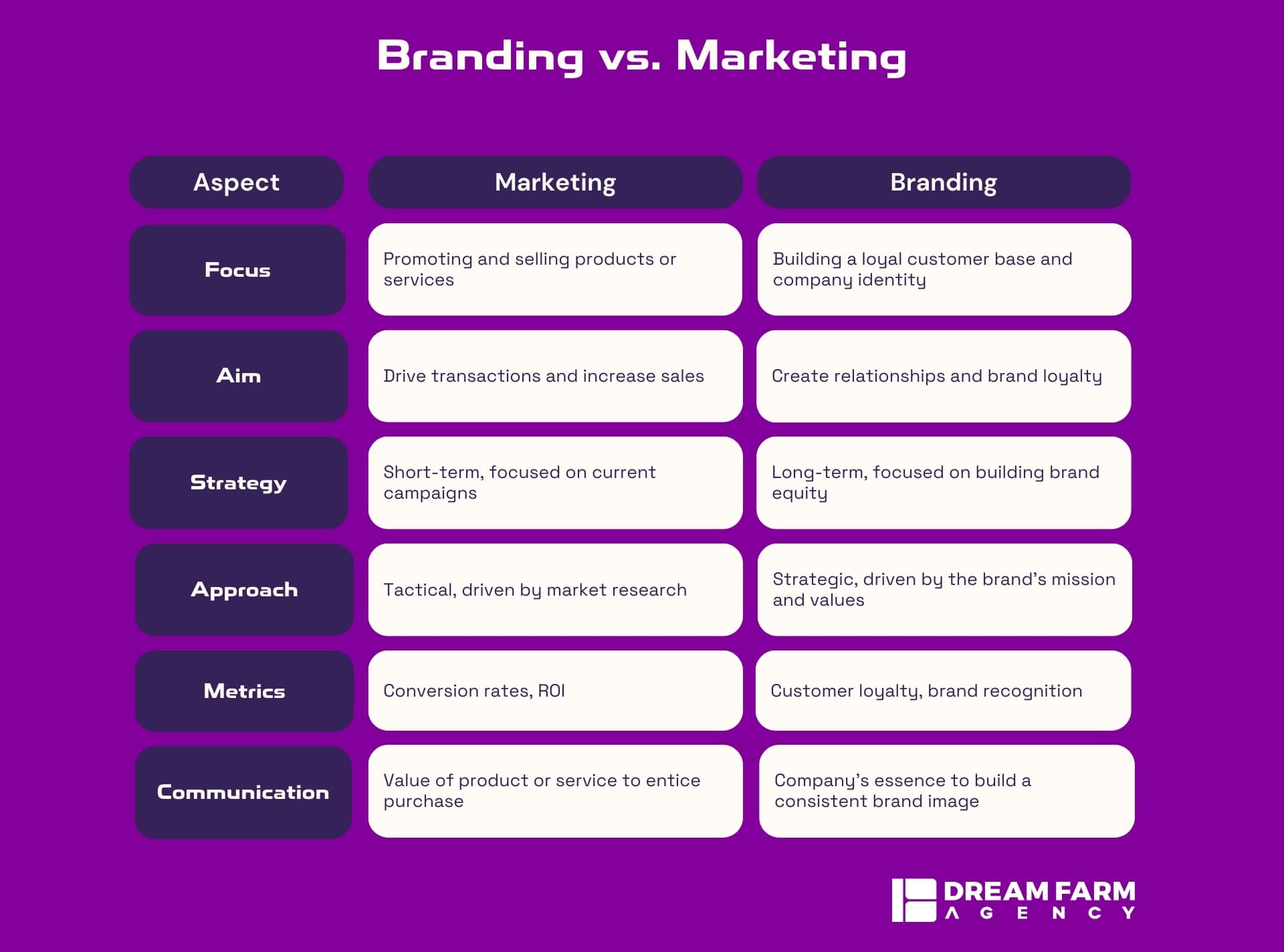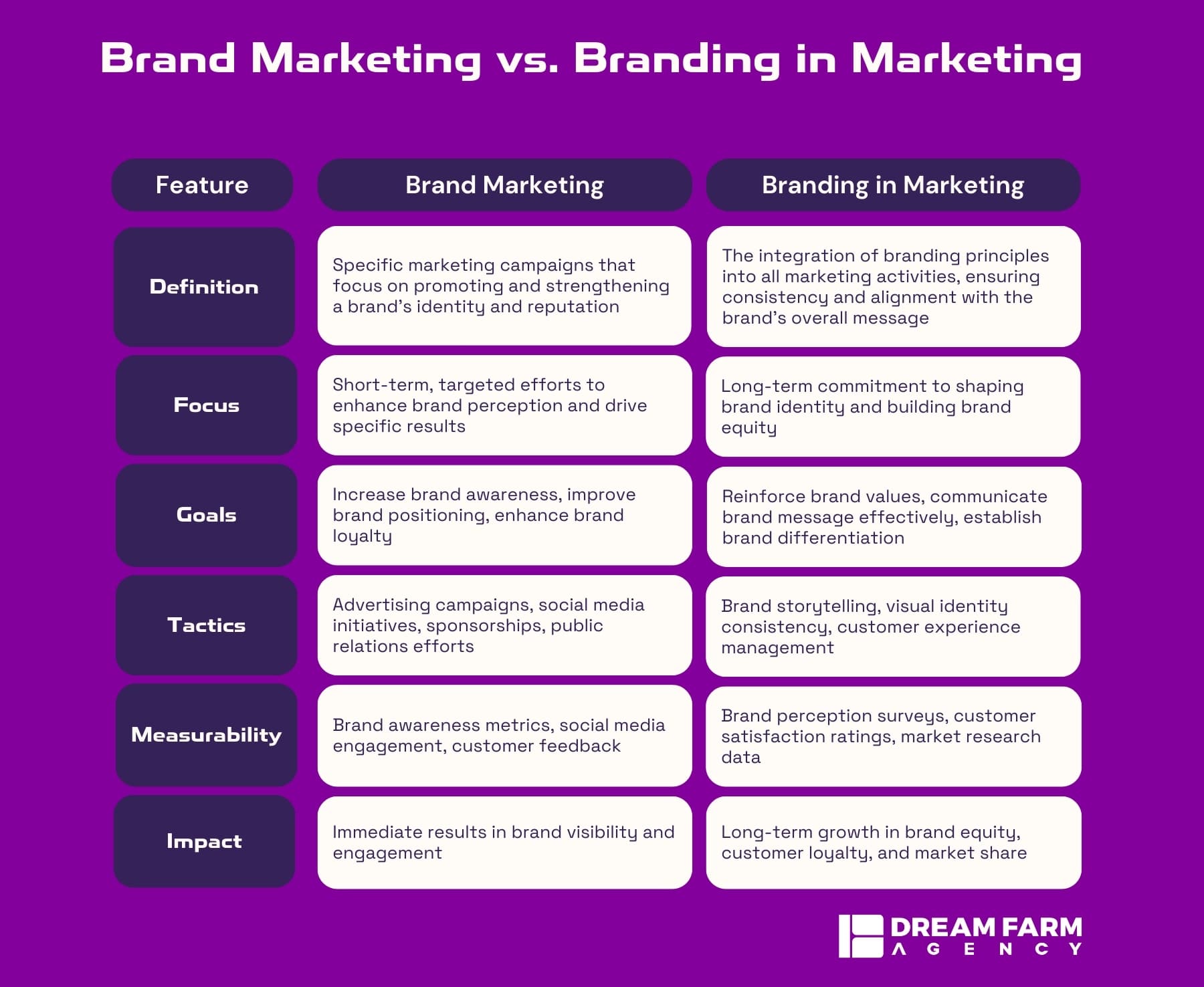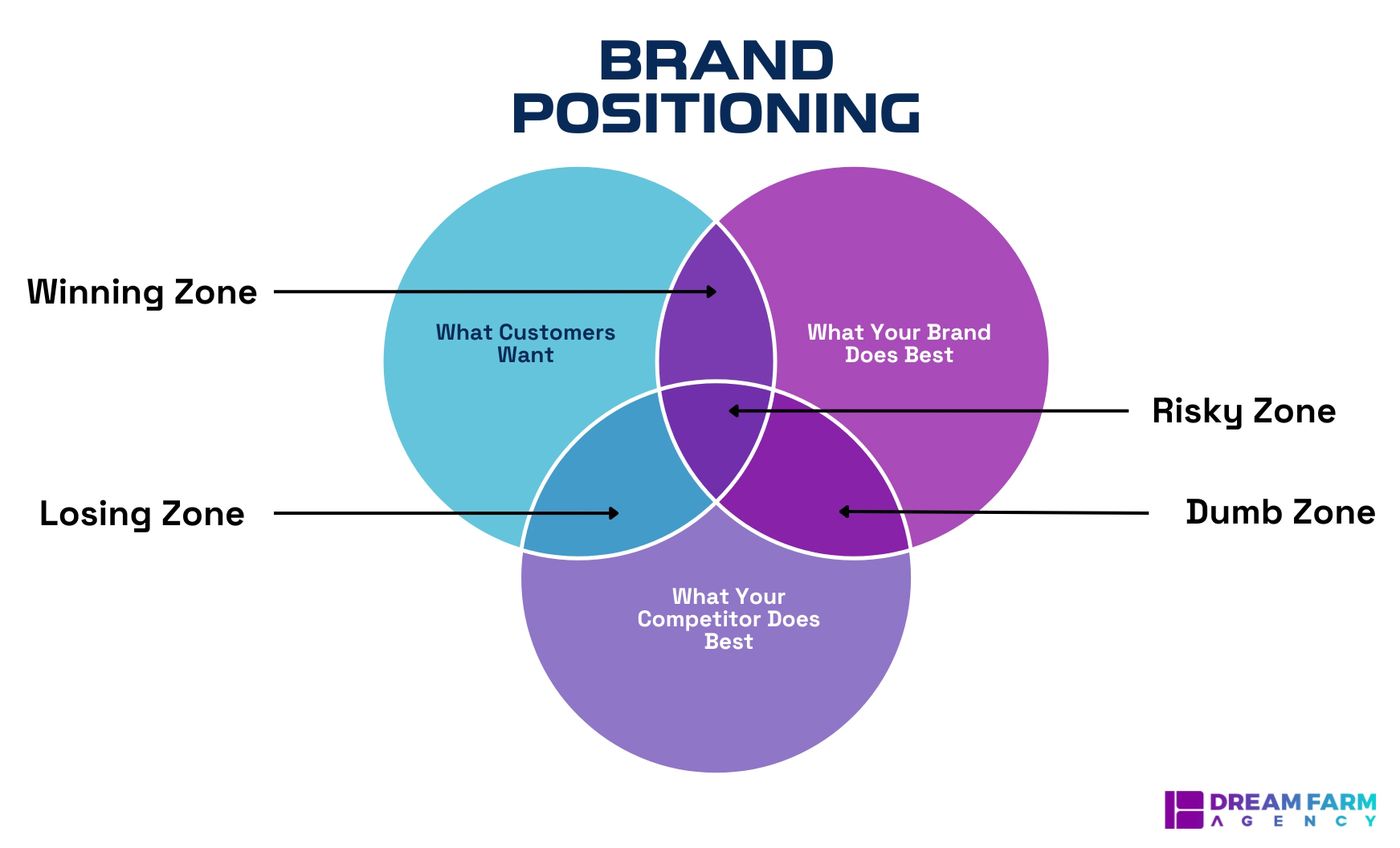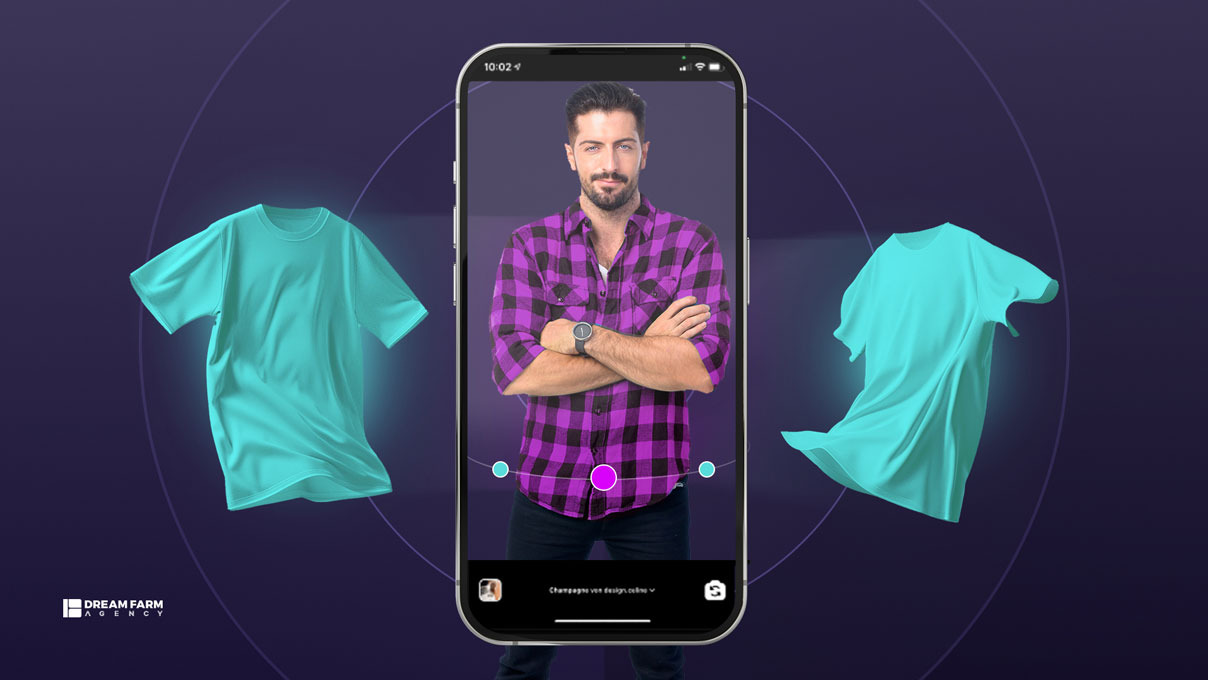Have you ever come across an advertisement that immediately grabs your attention? Whether it aligns with your emotions, attitudes, or opinions, this is the art of brand marketing in action.
It goes beyond promoting a product and involves an effective brand marketing strategy, which creates a positive brand experience in the consumer’s mind, especially in a competitive marketplace.
This article explores a comprehensive guide to brand marketing, the most worthwhile strategic activities, trends, and inspiring examples.
What Is Brand Marketing?
Brand marketing involves a long-term strategy to promote your products or services by influencing how people view your company as a whole. In order to create brand awareness and shape the consumers’ perceptions, you need to define your company’s goals, story, personality, and visual style.
In other words, brand marketing is an effective strategy to establish a brand identity that is recognizable through its visual and tangible elements, like logo, tone, narrative, social media, and website design.
Your brand identity needs to be based on emotional connections rooted in shared values and aspirations in order to create and retain customer loyalty.
If all these nuances are correctly implemented, brand marketing is expected to enhance customer experience and trust through strategies communicating the company’s vision. Further, your products or services will be easily recognized in the market.
Of course, effective brand marketing in the information age is a real challenge. So, having enough knowledge about equally important concepts enables marketers to master and fulfill their skills better.

Branding vs. Marketing
Branding, characterized by elements like company values, goals, and stories, serves as the soul of your business. It goes beyond the ‘visual’ aspects, creating an emotional connection with customers and distinguishing your company from competitors.
Marketing, on the other hand, adopts strategies to communicate the brand’s identity to different target audiences. Marketing encompasses diverse activities, from market research to advertising and search engine optimization.
Meanwhile, advertising is a part of marketing that enhances your business’s visibility across diverse channels. Utilizing various methods through traditional or digital media disseminates your message to a broad audience. Its primary goal is, of course, to prompt consumers to act based on their desires.
To give you an idea, consider Coca-Cola. Its identity revolves around a sense of joy, happiness, and fun. It is in its logo and slogan: ‘delicious and refreshing.’ It has used innovative marketing strategies to establish positive emotions in consumers. Coca-Cola has been using print and TV ads for over a century.
As a whole, marketing establishes the framework and is focused on generating excitement and guaranteeing that your products or services are appropriately positioned when needed. It is customer-oriented, meaning the requirements of the consumers are at the core of your business activities. Marketing indeed nurtures the community the branding efforts have formed.

Brand Marketing vs. Branding in Marketing
Brand Marketing involves employing diverse tools (print or digital media) to raise awareness about a specific brand and highlight its advantages to the target audience. It is a strategic approach that is crucial for communicating the brand identity.
The communication tools and channels available for brand and product marketing can be the same. However, an effective strategy often utilizes a blend of them to reach a wider audience.
Yet, branding plays a fundamental role in devising any marketing strategy and should take precedence. Successful branding attracts customers, fosters customer loyalty, and distinguishes a business from its competitors. So, marketing alone lacks efficacy without the value generated by branding.
Most importantly, while branding remains relatively unchanged, brand marketing is dynamic and requires adaptation to market trends. Although the consistency of what a brand stands for is vital for building credibility, the communication of these values, i.e., brand marketing, should evolve with market dynamics for continued effectiveness.
The relationship between branding and brand marketing is intertwined, and successful brand marketing promotes the brand, represents its core identity, and, when executed adeptly, cultivates customer loyalty and retention.

How to Develop a Brand Marketing Strategy?
Achieving a successful brand marketing strategy involves a thorough understanding of the following stepping stones and staying attuned to current trends. Such efforts can ultimately result in heightened sales and revenue.
Find Your Target Audience
The initial step in developing a brand marketing strategy is defining a target audience, which refers to the specific group of people a brand aims to reach through its marketing initiatives.
It includes the exploration of demographics, priorities, desires, and behaviors of the target audience, forming a foundation for a successful brand marketing strategy. More specifically, demographic factors involve age, gender, marital status, family size, income, education, and psychographics such as values, desires, and lifestyles.
For that reason, marketers employ market research to gather specific information about the target audience. According to Investopedia, market research, as an integral part of a business’s research and development (R&D) phase, can help shape and refine new offerings.
So, diverse methods, such as surveys, social media research, interviews, web analytics, and so on, can be applied to achieve a deeper understanding of the characteristics and personas of your audiences. They help businesses target audiences to make informed decisions in the targeted market.

Conduct Competitive Analysis
Businesses need to thoroughly assess and understand their competitors, including their strong and weak points, along with their brand marketing strategies, in order to gain a competitive edge. The main objective is not to imitate but to be recognized distinctly.
Begin by identifying your competitors based on your business niche, target audience, and location using online tools like Google Trends, Semrush, or SimilarWeb. Categorize and rank them into primary, secondary, and tertiary groups and consider factors like size, scope, marketing channels, and market share percentage.
Then, examine the visible branding elements used by your competitors. Remember to analyze their online presence, understand how they communicate their values and personality, and identify their exclusive selling proposition and market position. You may also need to conduct a SWOT (Strengths, Weaknesses, Opportunities, and Threats) analysis.
Having known your competitors, you now need to evaluate whether their brand marketing strategies have been efficient in creating brand awareness and customer loyalty. For that reason, identify their unique features and potential challenges. Finally, compare your brand with competitors in full detail using graphs and tables to distinguish your brand in the market.
Uber is a good model for effective competitor analysis. The company stands out by offering various ‘bonuses’ which enhance customer experience.
Develop Your Tone of Voice
The tone of voice refers to the personality of your content, both written and spoken, shaping how your audience engages with your brand and takes action. Thus, it should encapsulate the values of your brand and customers.
Crafting a well-defined brand voice is crucial for three main reasons: it sets your brand apart from competitors, helps you improve in accordance with the intended audience, and fosters a stronger connection with them.
These factors make a brand voice sound peculiar, targeted, and uniform, resulting in effective communication. It should further appeal to the consumers’ emotions beyond their immediate needs in a way that elicits an emotional response. Choosing a tone that resonates with the audience’s interests enhances brand recall.
We all know iconic models with strong voices that will always pertain to our minds. Harley Davidson is one of them. It has a rebellious, free, rugged, tough, and straightforward voice that resists conformity.
The right tone of voice is crucial for connecting with the audience and similar brands in order to convey messages and drive action. While brand voice remains consistent, adapting the tone for different platforms ensures flexibility and relevance.
Craft Your Brand Story
Traditional marketing in the digital era is ineffective as consumers seek control over the information they receive. Besides providing appropriate content, businesses also have to create their brands’ stories, simply explaining their origins and ongoing purpose.
An effective brand story helps customers understand the business’s identity and purpose. When consumers connect with the brand’s purpose, they are more likely to show loyalty and make purchases multiple times.
A brand story not only recalls the founding events but also emphasizes how and why the brand continues to thrive, fostering a connection with consumers.
Businesses have to control their narrative, especially as consumers increasingly prioritize value-driven choices. The 2022 Edelman Trust Barometer indicates that 58% of consumers are more inclined to support brands that align with their values and beliefs.
See how Adidas tied its brand story to the sports legends to transfer a valuable message: Impossible is nothing!
Therefore, crafting a compelling story enables brands to convey their identity and connect with consumers on shared values. Ultimately, building a brand story becomes a crucial tool for businesses to distinguish themselves and highlight their uniqueness in competitive markets.
Determine Your Brand Positioning
Brand positioning is a strategic approach in brand marketing that shapes how consumers perceive a business and establishes its position in their minds, fostering brand awareness. It involves creating associations in consumers’ minds to set the brand apart from competitors.

Walmart’s EDLP (Everyday low price) strategy is a bona fide classic example. Consumers don’t have to wait for special offers, discounts or events. It was aimed at direct sourcing to bypass middlemen. Win-win game!
Brand Positioning Statement
Hence, the brand positioning statement plays a crucial role in ingraining your niche in the market. A positioning statement offers a portrayal of your brand and its intended audience, detailing how it addresses a market requirement.
Marketing and sales teams leverage this statement to direct their messaging, ensuring uniformity across all communication channels. So, don’t mix up these terms:
Positioning Statement: Delineates a product and its intended consumer while elucidating how it addresses a need uniquely as compared to competitors. A brand positioning statement is so well-crafted that for internal and external communication.
Value Proposition: Clarifies the advantages and values your product offers to customers. It is commonly integrated into the brand positioning statement.
Mission Statement: A publicly presented tagline or statement that articulates your brand’s strategic approach.
The brand positioning statement precisely indicates the company’s actions, its intended audience, and the distinctive features that distinguish the brand.
Being distinguished as exceptional further requires you to offer superior product quality. The way beloved Adidas represents and reveals its performance capabilities indicates it is surely a dominant force in the footwear market. Considering affordability and presenting exceptional customer service can do magic.
Targeting social media platforms and emotional positioning are also helpful to engage your target audiences, like businesses that target people’s passion for organic foods on Instagram. Highlighting sustainability and eco-friendly practices also uses the same strategies as brand messaging to ensure common values.
Position your brand as the preferred platform and dominate your niche, using aspects that your competitors might overlook. So, every business needs to focus on cultural values and social campaigns to create a strong connection with the target audience, the way Netflix creates country-specific content.
Choosing the right positioning strategy is indeed crucial for your brand, and it requires continual adaptation to market changes and evolving consumer preferences.
Set SMART Brand Marketing Objectives
Your targets need to be aligned with broader business objectives. Therefore, they should follow the SMART framework; which means your goals need to be Specific, Measurable, Attainable, Relevant, and Time-bound.
Specific goals offer clear and easily understood outcomes, while measurable objectives involve tracking progress through quantifiable metrics like web traffic, cost per lead, and social media post views.
Setting attainable goals ensures productivity, taking possibilities and limitations into consideration. Moreover, relevant goals align with your general business strategy, and time-bound goals have clear start and finish dates, introducing accountability to meet deadlines.
For instance, vague goals like ‘increasing page views’ become more effective when transformed into a SMART objective. Instead, you can clearly specify that your business needs to increase page views by 40% within the next six months by implementing a new content marketing strategy and using social media.
SMART marketing goals not only help you identify potential obstacles and envision your business roadmap but also facilitate the development of marketing proposals and solutions.
Track and Analyze Brand Marketing Performance
Brand marketing strategy in the 21st century offers a significant advantage in measuring performance compared to traditional methods. Unlike conventional mediums like print ads, where tracking audience interaction is challenging, digital marketing provides tools for accurate and detailed performance analysis.
Currently, Google Analytics 4 (GA4) is a powerful free tool that tracks user interactions, hits, ecommerce purchases, and traffic. It allows companies to set marketing goals and access comprehensive reports.
Google Search Console (GSC) complements GA4 by providing insights into a website’s SEO performance, including impressions, clicks, click-through rates, and average search result positions.
You can also use tools like Qualtrics Brand Tracking Tool, which offers built-in AI capabilities that continuously monitor all channels. It provides you with real-time updates on your brand’s performance and valuable and actionable insights.
So, it is crucial to use measurable and tangible metrics to see whether your brand is gaining the intended visibility in the market or not. On that account, quantitative data and measurable KPIs (Key Performance Indicators) are also used to monitor brand performance, awareness, and recall.
Avoiding common mistakes in measuring marketing performance is essential for success. Relying on metrics that do not signify real performance, manually processing data without using tracking software, and measuring too soon are pitfalls to avoid.

Working with an agency can streamline the brand marketing measurement process and provide valuable insights for improvement. Dream Farm Agency can support your business with its expert opinions throughout your brand marketing journey.
How to Activate Your Brand?
Brand activation is aimed at transforming passive consumers into active customers. It is achieved through various activities, events, or campaigns to introduce or reintroduce the brand to its audience.
Usually, these activities involve some level of interaction, allowing potential customers to directly engage with the brand and understand how it could enhance their lifestyle.
Bringing in a well-known influencer or organizing a unique, enjoyable activity for attendees can make your brand resonate with a wider audience. For instance, hosting a cooking class with a celebrity chef could align your brand with food enthusiasts, showcasing how your products fit into their culinary experiences.
One notable type of brand activation is experiential marketing, which creates tangible experiences for consumers through various techniques. It aims to develop a deep emotional connection with a lasting impression that generates positive Word-of-Mouth Marketing (WOMM).
Product sampling, another effective brand activation tactic, directly engages potential customers, allowing them to try a product free of cost in order to build trust before making a purchase. In collaboration with Relish, a well-known product sampling agency, Tommy Hilfiger could achieve a 214% sales increase. So, don’t let it slide!
Also, the feedback you receive is precious and fundamental for your brand marketing strategy.
Furthermore, online initiatives, together with influencer marketing, can engage a global audience instantly, fostering meaningful connections with consumers. It is called ‘digital’ brand activation, which is treasured due to the inexpensive, fast, and easily measurable possibilities it offers.
Last but not least, influencers are trusted intermediaries. They share their genuine experiences with products or services. Leveraging influencer marketing builds trust and credibility and fosters a sense of community around the brand.
Brand activation, as a part of the marketing strategy, provides you with tons of data to modify and develop your plans. It casts light on your brand marketing efforts if only you and your team stay flexible.
Trends in Brand Marketing Strategy
Strong brand connection with consumers creates brand awareness, engagement, and conversions. Following trends may give you a gist of the current most implemented maneuvers.
Advanced Technology
Modern consumers look for personalized experiences. Accordingly, brands need to analyze data in order to modify content and products based on individual preferences.
With ongoing advancements in big data technologies and machine learning algorithms, it is expected that traditional marketing strategies will gradually be rendered obsolete.
We at Dream Farm Agency provide you with advanced interactive media solutions. You can take a look at our immersive tech toolbox and launch your digitally oriented brand marketing strategy.
Video Marketing
Video content has become an important tool for storytelling and brand awareness. Short-form video platforms like TikTok and YouTube have intensified the dominance of video marketing, catering to modern audiences’ shorter attention spans. Businesses can utilize short-form videos not just for advertisements but also for narrating brand stories.

Omnichannel Presence
Omnichannel marketing ensures consistency in your content, visuals (logos, colors, typography), and positioning statements across all channels and platforms. It enhances brand recognition, instills trust in your brand across new channels, and is held in the audience’s awareness.
This approach to brand marketing is intended to enhance consumer experience and optimize overall performance. It is aimed to adapt to preferences, foster stronger relationships, and ultimately guide customers toward conversion.
The focus is on crafting a seamless journey that spans all various contact points. In order to reach the desired outcomes, you need to stay consistent across all channels, offer harmonized and personalized experiences, and optimize your brand messaging with a focus on measurable and verifiable data.
This trend is expected to evolve with advancements in big data technologies and machine learning algorithms.
Branded Content
The integration of branded content in your brand marketing strategy creates credibility. Consumers recognize and trust your brand if only you believe the fact that it is not just a marketing tool, but a set of information to educate them.
Considering your target audience and creating your brand voice are also fundamental factors in branded content. Furthermore, your business should be responsible for considering feedback for crafting consistent and reliable content.
Your branded content needs to be authentic and valuable. All efforts should be conducted to educate, entertain, and inspire the audience. Address your audience’s questions and offer resources relevant to their projects to enhance engagement.
The most important technique in crafting branded content is to incorporate real-life stories and expert interviews to make your content more compelling. So, remember to utilize storytelling techniques to emotionally connect with your audience, making your content engaging and shareable.
You may even want to take one more step and address conflicts and tensions your audience may face. Showcasing your expertise, building trust, and providing a clear solution to their problems.
Wrapping Up
Businesses prioritize addressing customers’ needs in their brand marketing strategies to drive revenue through positive experiences. Although this principle remains valid, economic difficulties are negatively influencing companies’ and customers’ finances.

As both brands and customers face the need to cut expenses, continuing on this trajectory may intensify frustration and adversely impact long-term prospects. Tight finances during such periods undermine loyalty. Despite this, customers’ emotional behaviors, along with technological advancements, are evolving faster than businesses can imagine, presenting an ongoing challenge.
These subtleties highlight the importance of both price and value. Brands must strategize to stay attuned to customers and maintain long-term product loyalty. They need to navigate a path that surveys cost considerations with profitability, avoiding transferring the burden of price hikes directly to the customer.
Meanwhile, they need to be responsive and improve people’s experiences, considering the global transformation. State-of-the-art technologies, specifically Generative AI, are reconstructing the way individuals engage with the internet.
With the utilization of large language models, generative AI facilitates intelligent, two-way conversations, offering solutions for specific intentions.
After all, those adept at leveraging this technology will accomplish favorable outcomes, communicate more effectively, and enhance people’s sense of understanding.
If you need personalized and in-depth consultation for better interactive solutions, contact us or share your queries in the comment box below.






